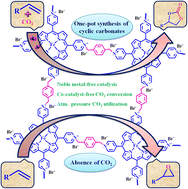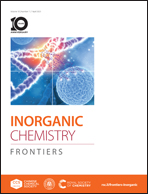Ionic Fe(iii)-porphyrin frameworks for the one-pot synthesis of cyclic carbonates from olefins and CO2†
Abstract
In this study, the rational construction of FeIII-centered porphyrin-based bifunctional ionic porous organic polymers (Fe-IPOP1/2) for a one-step, halogen-free, cascade transformation of olefins and CO2 to cyclic carbonates as compared to the conventional two-step process involving epoxides is presented. The ionic polymers, Fe-IPOP1/2 showed selective and recyclable uptake of CO2 with an interaction energy of 32.2/39.6 kJ mol−1 signifying the stronger interaction of carbon dioxide with the frameworks. Both the polymers were found to be thermally stable up to 300 °C and exhibited promising catalytic performance in the one-step, halogen-free synthesis of cyclic carbonates under eco-friendly, cocatalyst/solvent-free, atmospheric pressure conditions. The excellent catalytic activity of Fe-IPOP1/2 for a one-pot synthesis of cyclic carbonates has been ascribed to the presence of highly exposed oxophilic FeIII sites and nucleophilic Br− anions in the polymers. Notably, this one-pot synthesis strategy was extended for the transformation of various substituted olefins to their respective carbonates in good yield and selectivity. Further, Fe-IPOP1 showed good reusability with retention of catalytic activity for multiple cycles of usage.

- This article is part of the themed collection: 2023 Inorganic Chemistry Frontiers HOT articles


 Please wait while we load your content...
Please wait while we load your content...